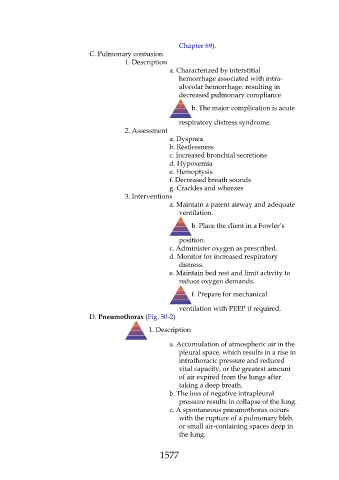Page 1577 - Saunders Comprehensive Review For NCLEX-RN
P. 1577
Chapter 69).
C. Pulmonary contusion
1. Description
a. Characterized by interstitial
hemorrhage associated with intra-
alveolar hemorrhage, resulting in
decreased pulmonary compliance
b. The major complication is acute
respiratory distress syndrome.
2. Assessment
a. Dyspnea
b. Restlessness
c. Increased bronchial secretions
d. Hypoxemia
e. Hemoptysis
f. Decreased breath sounds
g. Crackles and wheezes
3. Interventions
a. Maintain a patent airway and adequate
ventilation.
b. Place the client in a Fowler’s
position.
c. Administer oxygen as prescribed.
d. Monitor for increased respiratory
distress.
e. Maintain bed rest and limit activity to
reduce oxygen demands.
f. Prepare for mechanical
ventilation with PEEP if required.
D. Pneumothorax (Fig. 50-2)
1. Description
a. Accumulation of atmospheric air in the
pleural space, which results in a rise in
intrathoracic pressure and reduced
vital capacity, or the greatest amount
of air expired from the lungs after
taking a deep breath.
b. The loss of negative intrapleural
pressure results in collapse of the lung.
c. A spontaneous pneumothorax occurs
with the rupture of a pulmonary bleb,
or small air-containing spaces deep in
the lung.
1577

